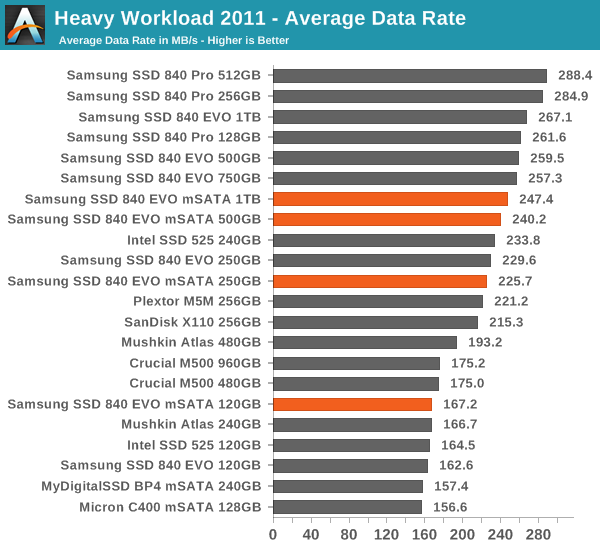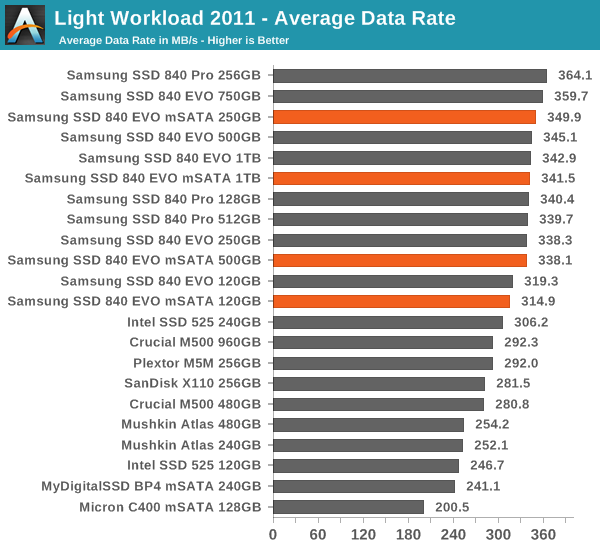Samsung SSD 840 EVO mSATA (120GB, 250GB, 500GB & 1TB) Review
by Kristian Vättö on January 9, 2014 1:35 PM ESTAnandTech Storage Bench 2011
Two years ago we introduced our AnandTech Storage Bench, a suite of benchmarks that took traces of real OS/application usage and played them back in a repeatable manner. Anand assembled the traces out of frustration with the majority of what we have today in terms of SSD benchmarks.
Although the AnandTech Storage Bench tests did a good job of characterizing SSD performance, they weren't stressful enough. All of the tests performed less than 10GB of reads/writes and typically involved only 4GB of writes specifically. That's not even enough exceed the spare area on most SSDs. Most canned SSD benchmarks don't even come close to writing a single gigabyte of data, but that doesn't mean that simply writing 4GB is acceptable.
Originally the benchmarks were kept short enough that they wouldn't be a burden to run (~30 minutes) but long enough that they were representative of what a power user might do with their system.
1) The MOASB, officially called AnandTech Storage Bench 2011 - Heavy Workload, mainly focuses on the times when your I/O activity is the highest. There is a lot of downloading and application installing that happens during the course of this test. Our thinking was that it's during application installs, file copies, downloading and multitasking with all of this that you can really notice performance differences between drives.
2) We tried to cover as many bases as possible with the software incorporated into this test. There's a lot of photo editing in Photoshop, HTML editing in Dreamweaver, web browsing, game playing/level loading (Starcraft II & WoW are both a part of the test) as well as general use stuff (application installing, virus scanning). We've included a large amount of email downloading, document creation and editing as well. To top it all off we even use Visual Studio 2008 to build Chromium during the test.
The test has 2,168,893 read operations and 1,783,447 write operations. The IO breakdown is as follows:
| AnandTech Storage Bench 2011 - Heavy Workload IO Breakdown | ||||
| IO Size | % of Total | |||
| 4KB | 28% | |||
| 16KB | 10% | |||
| 32KB | 10% | |||
| 64KB | 4% | |||
Only 42% of all operations are sequential, the rest range from pseudo to fully random (with most falling in the pseudo-random category). Average queue depth is 4.625 IOs, with 59% of operations taking place in an IO queue of 1.
AnandTech Storage Bench 2011 - Heavy Workload

The full data set including disk busy times and read/write separation can be found in our Bench.
AnandTech Storage Bench 2011 - Light Workload
Our light workload actually has more write operations than read operations. The split is as follows: 372,630 reads and 459,709 writes. The relatively close read/write ratio does better mimic a typical light workload (although even lighter workloads would be far more read centric). There's lots of web browsing, photo editing (but with a greater focus on photo consumption), video playback as well as some application installs and gaming.
The I/O breakdown is similar to the heavy workload at small IOs, however you'll notice that there are far fewer large IO transfers. Interestingly, the 480GB drive actually comes out ahead in this case, suggesting it's more capable at light workloads.
| AnandTech Storage Bench 2011 - Light Workload IO Breakdown | ||||
| IO Size | % of Total | |||
| 4KB | 27% | |||
| 16KB | 8% | |||
| 32KB | 6% | |||
| 64KB | 5% | |||











65 Comments
View All Comments
5mpx - Friday, January 10, 2014 - link
I recently picked up a Samsung 840 Pro 120GB for around $115 to replace the absolutely dreadful Samsung 1TB 5400RPM w/ 8GB SanDisk iSSD ExpressCache (which also seemed absolutely useless) on mainboard.Couldn't be happer - my Core i7 actually has to do some work now instead of sitting around waiting on the drive to feed it data.
dgingeri - Thursday, January 9, 2014 - link
I bet a ship from the future crashed in Seoul, and Samsung is out there reverse engineering technology from it to dominate the technology market. ;)Jarn - Thursday, January 9, 2014 - link
With these speeds, I just go with whichever of the seemingly most reliable brands are cheapest.BigAnvil - Friday, January 10, 2014 - link
Please, oh please, oh please, oh please... let someone make a miniature RAID box for mSata SSDs!!!!!!!!! Room for five mSata SSDs like this with striping and either a Thunderbolt 2 or USB 3.1 interface so we can all have multi-Gigabyte/sec transfer rates that can fit in ur shirt pocketses.Brenderick - Saturday, February 15, 2014 - link
http://www.mfactors.com/raid-card-msata/Not five, but it will cram a pair of them under a RAID controller into a 2.5 inch package. You could, in theory, RAID three of these together in a NAS and you would have what you are describing.
a1exh - Friday, January 10, 2014 - link
Samsung are not the only Vertically Integrated provider in consumer SSD space. Toshiba is also.Kristian Vättö - Friday, January 10, 2014 - link
Toshiba doesn't make their own controllers, they are just rebrands.Brenderick - Saturday, February 15, 2014 - link
Lacks controller IP.unclebump2013 - Friday, January 10, 2014 - link
it does exist. http://addonics.com/products/ad4mspx2.phpextide - Friday, January 10, 2014 - link
No, that's for mSATA, not M.2